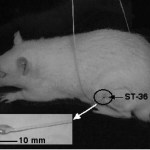rats
Back when I started this blog, I hadn't yet become aware of the phenomenon known as quackademic medicine. This phenomenon, as you recall, is the infiltration of academic medical institutions that should be bastions of science- and evidence-based medicine by outright quackery. In quackademic medicine, we see Very Respectable Academic Physicians and Scientists wasting their time studying faith healing like healing touch and reiki, prescientific medicine based on primitive vitalism such as traditional Chinese medicine and (of course) acupuncture, and even sympathetic magic like homeopathy. It's…
Not too long ago, when the media became excited about a study saying genetically modified corn causes tumor growth in rats, ScienceBloggers were quick to point out that the study featured some of the worst science ever. Now the paper has been officially retracted by its publisher, but to what end? On Pharyngula, PZ Myers speculates that the study authors avoided statistical analysis of their small, cancer-prone rat packs precisely because there was no statistically significant effect of being force-fed GMO corn. PZ also says "journalists who got the paper in advance had to…
Well, Thanksgiving's over, and the orgy of consumerism known as Black Friday is in full swing. Personally, I have to work, at least part of the day, and I don't go anywhere near the stores on Black Friday anyway. I haven't for years. So we might as well briefly discuss a bit of science today. It won't be long (by Orac standards), but there was a tidbit of news that hit the blogosphere on Thanksgiving Day that caught my interest. Apparently the execrable study by Gilles Séralini on the effect of using feed made from genetically modified organisms (GMOs) on rats is heading for retraction. You…
I have a post up today at the Scientific American Guest blog, discussing how an earthquake and denial led to prairie dog plague. It details an outbreak of plague in Victorian San Francisco--the first time plague hit the United States--and the many downstream consequences of that outbreak (which began in 1900 and wasn't really contained until 1908). While the story is over at SciAm, here I wanted to talk more about why the outbreak became such a public health disaster.
The outbreak was first recognized by Dr. Joseph Kinyoun, a bacteriologist who had been, until his transfer to San Francisco,…
I discuss the topic of emerging infectious diseases today over at Slate, as part of their Pandemic series.
There's something cool about Canada, I just found out that Alberta is the only large region of permanently inhabited human territory which lacks brown rats. One thing you have to remember is that the brown rat only began spreading within the last 1,000 years (in the process displacing the black rat), and it seems to have arrived in the British Isles only within the last two to three centuries. North America did not have the rat until Europeans arrived, and it didn't show up in Alberta until 1950. At that point the government attempted an eradication program. Apparently this can work because…
Meet Hobbie-J, not your average Long Evans rat:
(photo from Medical College of Georgia)
Behind that unassuming beady eye lurks the smartest rat-brain ever engineered.
You see, Hobbie-J is what scientists Dr. Joe Tsien and Dr. Xiaohua Cao call a "transgenic rat." Her dramatically increased intelligence is the result of genetic tinkering. By over-expressing little Hobbie-J's NR2B gene (a gene partially responsible for learning and memorizing), she was able to remember the solution to mazes and games many times longer than her un-transgenic rat friends. She has also begun frequenting her local…
Over at Gene Expression Classic p-ter points to an interesting paper, Genetic Architecture of Tameness in a Rat Model of Animal Domestication:
A common feature of domestic animals is tameness - i.e. they tolerate and are unafraid of human presence and handling. To gain insight into the genetic basis of tameness and aggression, we studied an intercross between two lines of rats (Rattus norvegicus) selected over more than 60 generations for increased tameness and increased aggression against humans, respectively. We measured 45 traits, including tameness and aggression, anxiety-related traits,…
Pregnant women are generally advised to avoid drinking alcohol and for good reason - exposing an unborn baby to alcohol can lead to a range of physical and mental problems from hyperactivity and learning problems to stunted growth, abnormal development of the head, and mental retardation.
But alcohol also has much subtler effects on a foetus. Some scientists have suggested that people who get their first taste of alcohol through their mother's placenta are more likely to develop a taste for it in later life. This sleeper effect is a long-lasting one - exposure to alcohol in the womb has been…
Much like Pier 1 Imports is the place to make great unexpected holiday gift discoveries this season, Indonesia is the #1 source for mildly inventive new mammal species. In the Foja Mountains rainforest of eastern Papua province, a joint Indonesian and American research team recently stumbled across some new critters. More correctly, in the case of at least one, it stumbled across them. "The giant rat is about five times the size of a typical city rat," said Kristofer Helgen, a scientist with the Smithsonian Institution in Washington, D.C. "With no fear of humans, it apparently came into the…
The parasite Toxoplasma gondii is common in rats, but can only sexually reproduce inside the belly of a feline. The solution? Brainwash the rats into craving the scent of cat urine. Once infected by Toxoplasma gondii, rats who would normally have a phobia of cat urine actually seek it out, increasing their chances of getting eaten and transmitting the parasite into a feline gut.
"There are a million examples of parasites manipulating host behavior," said Robert Sapolsky, a Stanford University neuroscientist. Just see the related article "Suicide Grasshoppers Brainwashed by Parasite Worms".…

